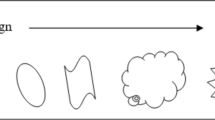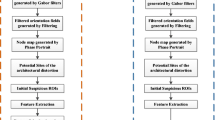Abstract
Architectural distortion (AD) is a common cause of false-negatives in mammograms. This lesion usually consists of a central retraction of the connective tissue and a spiculated pattern radiating from it. This pattern is difficult to detect due the complex superposition of breast tissue. This paper presents a novel AD characterization by representing the linear saliency in mammography Regions of Interest (ROI) as a graph composed of nodes corresponding to locations along the ROI boundary and edges with a weight proportional to the line intensity integrals along the path connecting any pair of nodes. A set of eigenvectors from the adjacency matrix is then used to extract discriminant coefficients that represent those nodes with higher salient lines. A dimensionality reduction is further accomplished by selecting the pair of nodes with major contribution for each of the computed eigenvectors. The set of main salient lines is then assembled as a feature vector that inputs a conventional Support Vector Machine (SVM). Experimental results with two benchmark databases, the mini-MIAS and DDSM databases, demonstrate that the proposed linear saliency domain method (LSD) performs well in terms of accuracy. The approach was evaluated with a set of 246 RoI extracted from the DDSM (123 normal tissues and 123 AD) and a set of 38 ROI from the mini-MIAS collections (19 normal tissues and 19 AD) respectively. The classification results showed respectively for both databases an accuracy rate of 89 % and 87 %, a sensitivity rate of 85 % and 95 %, and a specificity rate of 93 % and 84 %. Likewise, the area under curve (A z ) of the Receiver Operating Characteristic (ROC) curve was 0.93 for both databases.










Similar content being viewed by others
References
American Cancer Society: Breast Cancer: Tech. rep. American Cancer Society, Atlanta (2015)
Ayres, F. J., and Rangayyan, R. M., Characterization of architectural distortion in mammograms. IEEE Enginering in Medicine and Biology Magazine,59–67, 2005.
Ayres, F. J., and Rangayyan, R. M., Reduction of false positives in the detection of architectural distortion in mammograms by using a geometrically constrained phase portrait model. International Journal of Computer Assisted Radiology and Surgery 1:361–369, 2007.
Baker, J. A., Rosen, E. L., Lo, J. Y., Gimenez, E. I., Walsh, R., Soo, M. S., Computer-Aided detection (CAD) in screening mammography: Sensitivity of commercial CAD systems for detecting architectural distortion. American Journal of Roentgenology 181(4):1083–1088, 2003.
Banik, S. M., Rangayyan, R., Desautels, J. E. L., Detection of Architectural Distortion in Prior Mammograms. IEEE Transactions on Medical Imaging 30(2):279–294, 2011.
Bird, R., Wallace, T., Yankaskas, B., Analysis of cancers missed at screening mammography. Radiology 178:234–247, 1992.
Biswas, S. K., and Mukherjee, D. P., Recognizing architectural distortion in mammogram: a multiscale texture modeling approach with GMM. IEEE Transactions on Biomedical Engineering 58(7):2023–2030, 2011.
Bovik, A. C., Huang, T. S., Munson Jr, D. C., A generalization of median filtering using linear combinations of order statistics. IEEE Transactions on Acoustics, Speech and Signal Processing 31(6):1342–1350, 1983.
Chang, C. C., and Lin, C. J., LIBSVM : a library for support vector machines. ACM Transactions on Intelligent Systems and Technology 2(27):1–27, 2011.
Chiarelli, A. M., Edwards, S. A., Prummel, M. V., Muradali, D., Majpruz, V., Done, S. J., Brown, P., Shumak, R. S., Yaffe, M. J., Digital compared with Screen-Film mammography: Performance measures in concurrent cohorts within an organized breast screening program. Radiology 268(3):684–693, 2013.
Cortes, C., and Vapnik, V., Support-Vector Networks. Mach. Learn. 20 (3): 273–297, 1995. doi:10.1023/A:1022627411411.
Freeman, L. C., Centrality in social networks: Conceptual clarification. Social Networks 1:215–239, 1979.
Gopalakrishnan, V., Hu, Y., Rajan, D., Random Walks on Graphs for Salient Object Detection in Images. IEEE Transactions on Image processing 19:3232–3242, 2010.
Guo, Q., Shao, J., Ruiz, V., Investigation of support vector machine for the detection of architectural distortion in mammographic images. Journal of Physics 15:88–94, 2005.
Heath, M., Bowyer, K., Kopans, D., Moore, R., Kegelmeyer, W. P.: The Digital Database for Screening Mammography. In: Proceedings of the Fifth International Workshop on Digital Mammography, pp. 212–218. Medical Physics Publishing, M.J. Yaffe (2001)
Horsch, A., Hapfelmeier, A., Elter, M., Needs assessment for next generation computer-aided mammography reference image databases and evaluation studies. International Journal of Computer Assisted Radiology and Surgery 6(6):749–767, 2011.
Ichikawa, T., Matsubara, T., Hara, T., Fujita, H., Endo, T., Iwase, T.: Automated detection method for architectural distorion areas on mammograms based on morphological processing and surface analysis. In: Processing, I. (Ed.) Medical imaging, Vol. 5370 (2004)
Kamra, A., Jain, V. K., Singh, S., Mittal, S., Characterization of Architectural Distortion in Mammograms Based on Texture Analysis Using Support Vector Machine Classifier with Clinical Evaluation. Journal of Digital Imaging,1–11, 2015. doi:10.1007/s10278-015-9807-3.
Karssemeijer, N., and Te Brake, G. M., Detection of stellate distortions in mammograms. IEEE Transactions on Medical Imaging 15(5):611–619, 1996.
Lei, T., and Sewchand, W., Statistical approach to X-ray CT imaging and its applications in image analysis. II . A new stochastic model-based image segmentation technique for X-ray CT image. IEEE Transactions on Medical Imaging 11(1):62–69, 1992.
Matsubara, T., Ito, A., Tsunomori, A., Hara, T., Muramatsu, C., Endo, T., Fujita, H.: An automated method for detecting architectural distortions on mammograms using direction analysis of linear structures. In: Engineering in Medicine and Biology Society (EMBC), 2015 37th Annual International Conference of the IEEE. doi:10.1109/EMBC.2015.7318939 10.1109/EMBC.2015.7318939, pp. 2661–2664 (2015)
Morton, M. J., Whaley, D. H., Brandt, K. R., Amrami, K. K., Screening Mammograms: Interpretation with Computer aided Detection Prospective Evaluation. Radiology 239(2):375–383, 2006. doi:10.1148/radiol.2392042121.
Moura, D. C., and Guevara López, M. A., An evaluation of image descriptors combined with clinical data for breast cancer diagnosis. International journal of computer assisted radiology and surgery 8(4):561–574, 2013. doi:10.1007/s11548-013-0838-2. http://www.ncbi.nlm.nih.gov/pubmed/23580025.
Narváez, F., Díaz, G., Gómez, F., Romero, E.: A content-based retrieval of mammographic masses using the curvelet descriptor. In: Proceedings of the SPIE, Vol. 8315, pp. 83,150A–83,150A–7 (2012), 10.1117/12.911680
Narváez, F., and Romero, E.: Breast mass classification using orthogonal moments. In: Maidment, S., Andrew, D. A., Bakic, P. R., Gavenonis, S. (Eds.) Breast Imaging, lecture no edn., pp. 64–71. Springer (2012), 10.1007/978-3-642-31271-7_9
Nemoto, M., Honmura, S., Shimizu, A., Furukawa, D., Kobatake, H., Nawano, S., A pilot study of architectural distortion detection in mammograms based on characteristics of line shadows. International Journal of Computer Assisted Radiology and Surgery 4(1):27–36, 2009.
Nithya, R., and Santhi, B., Computer Aided Diagnosis System for Mammogram Analysis: A Survey. Journal of Medical Imaging and Health Informatics 5(4):653–674, 2015. doi:10.1166/jmihi.2015.1441.
Parr, T. C., Taylor, C. J., Astley, S. M., Boggis, C. R. M., Statistical modeling of oriented line patterns in mammograms, pp. 44–55: International society for optics and photonics, 1997.
Pisano, E. D., Zong, S., Hemminger, B. M., DeLuca, M., Johnston, R. E., Muller, K., Braeuning, M. P., Pizer, S. M., Contrast limited adaptive histogram equalization image processing to improve the detection of simulated spiculations in dense mammograms. Journal of Digital Imaging 11:193– 200, 1998.
Rangayyan, R., Banik, S., Desautels, J., Computer-Aided Detection of Architectural Distortion in Prior Mammograms of Interval Cancer. Journal of Digital Imaging 23(5):611–631, 2010. doi:10.1007/s10278-009-9257-x.
Rangayyan, R. M., Chakraborty, J., Banik, S., Mukhopadhyay, S., Desautels, J. E. L., Detection of Architectural Distortion Using Coherence in Relation to the Expected Orientation of Breast Tissue. IEEE Transactions on CBMS 2:1–4, 2012.
Rao, A. R., and Jain, R. C., Computerized flow field analysis: Oriented texture fields. IEEE Trans. Pattern Anal. Mach. Intell. 14(7):693–709, 1992.
Redondo, A., Comas, M., Maciȧ, F., Ferrer, F., Murta-Nascimento, C., Maristany, M. T., Molins, E., Sala, M., Castells, X., Inter- and intraradiologist variability in the BI-RADS assessment and breast density categories for screening mammograms. The British journal of radiology 85(1019):1465–1470, 2012.
Sampat, M. P., Markey, M. K., Bovik, A. C.: Measurement and detection of spiculated lesions. In: Image analysis and interpretation, pp. 105–109 (2006)
Sampat, M. P., Whitman, G. J., Markey, M. K., Bovik, A. C., Evidence based detection of spiculated masses and architectural distortions, pp. 26–37: International society for optics and photonics, 2005, 2005.
Sickles, E. A., DȮrsi, C. J., Bassett, L. W., Al., E., ACR BI-RADS Mammography. 5th edit edn. Reston, VA: American College of Radiology, 2013.
Suckling, J., Parker, J., Dance, D., Astley, S., Hutt, I., Boggis, C., Ricketts, I., Stamatakis, E., Cerneaz, N., Kok, S., Others: The Mammographic Image Analysis Society Digital Mammogram Database. In: Series, I.c. (Ed.) exerpta medica, Vol. 1069, pp. 375–378 (1994)
Tabar, L., Yeng, M. F., Vitak, B., Cheng, H. H. T., Smith, R. A., Duffy, S. W., Mammography service screening and mortality in breast cancer patients: 20-year follow ∖-up before and after introduction of screening. Lacent 361:1405–1410, 2003.
Tourassi, G. D., Delong, D. M., Floyd, C. E., A study on the computerized fractal analysis of architectural distortion in screening mammograms. Physics in Medicine and Biology 51(5):1299–1312, 2006.
Zhang, X., A New Ensemble Learning Approach for Microcalcification Clusters Detection. Journal of Software 4(9):1014–2021, 2009.
Zwiggelaar, R., Astley, S. M., Boggis, C. R. M., Taylor, C. J., Linear structures in mammographic images: Detection and classification. IEEE Transactions on Medical Imaging 23(9):1077–1086, 2004.
Zwiggelaar, R., Parr, T. C., Schumm, J. E., Hutt, I. W., Taylor, C. J., Astley, S. M., Boggis, C. R. M., Model-based detection of spiculated lesions in mammograms. Medical Image Analysis 3(1):39–62, 1999.
Acknowledgments
This work was partially supported by the Ecuadorian government through ”La Secretaría de Educación Superior, Ciencia, Tecnología e Innovacion (SENESCYT)”, [Grant number: 20110958, 2011].
Author information
Authors and Affiliations
Corresponding author
Additional information
This article is part of the Topical Collection on Systems-Level Quality Improvement
Rights and permissions
About this article
Cite this article
Narváez, F., Alvarez, J., Garcia-Arteaga, J.D. et al. Characterizing Architectural Distortion in Mammograms by Linear Saliency. J Med Syst 41, 26 (2017). https://doi.org/10.1007/s10916-016-0672-5
Received:
Accepted:
Published:
DOI: https://doi.org/10.1007/s10916-016-0672-5




